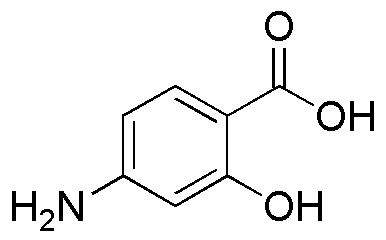4-Aminosalicylic acid is widely utilized in research focused on
- Tuberculosis Treatment: This compound is primarily used as an anti-tubercular agent, especially in cases resistant to other medications. It helps in effectively reducing the bacterial load in patients.
- Pharmaceutical Formulations: It is incorporated into various pharmaceutical products, enhancing the efficacy of treatments for respiratory diseases due to its ability to inhibit bacterial growth.
- Research in Drug Development: Researchers use it as a model compound to study the mechanisms of drug resistance in bacteria, aiding in the development of new antibiotics.
- Analytical Chemistry: 4-Aminosalicylic acid serves as a standard in analytical methods for quantifying similar compounds, ensuring accuracy in pharmaceutical quality control.
- Biochemical Studies: It is utilized in biochemical assays to investigate metabolic pathways, providing insights into cellular processes and potential therapeutic targets.
Informations générales
Propriétés
Sécurité et réglementation
Applications
4-Aminosalicylic acid is widely utilized in research focused on
- Tuberculosis Treatment: This compound is primarily used as an anti-tubercular agent, especially in cases resistant to other medications. It helps in effectively reducing the bacterial load in patients.
- Pharmaceutical Formulations: It is incorporated into various pharmaceutical products, enhancing the efficacy of treatments for respiratory diseases due to its ability to inhibit bacterial growth.
- Research in Drug Development: Researchers use it as a model compound to study the mechanisms of drug resistance in bacteria, aiding in the development of new antibiotics.
- Analytical Chemistry: 4-Aminosalicylic acid serves as a standard in analytical methods for quantifying similar compounds, ensuring accuracy in pharmaceutical quality control.
- Biochemical Studies: It is utilized in biochemical assays to investigate metabolic pathways, providing insights into cellular processes and potential therapeutic targets.
Documents
Fiches de données de sécurité (FDS)
La FDS fournit des informations de sécurité complètes sur la manipulation, le stockage et l’élimination du produit.
Spécifications du produit (PS)
Le PS fournit une description complète des propriétés du produit, notamment sa composition chimique, son état physique, sa pureté et les exigences de stockage. Il détaille également les plages de qualité acceptables et les applications prévues du produit.
Certificats d'analyse (COA)
Recherchez des certificats d'analyse (COA) en saisissant le numéro de lot du produit. Les numéros de lot et de lot se trouvent sur l'étiquette d'un produit, après les mots « Lot » ou « Lot de fabrication ».
Numéro de catalogue
Numéro de lot/série
Certificats d'origine (COO)
Ce certificat d'exploitation confirme le pays dans lequel le produit a été fabriqué, et détaille également les matériaux et composants utilisés et s'il est issu de sources naturelles, synthétiques ou autres sources spécifiques. Ce certificat peut être requis pour les douanes, le commerce et la conformité réglementaire.
Numéro de catalogue
Numéro de lot/série
Fiches de données de sécurité (FDS)
La FDS fournit des informations de sécurité complètes sur la manipulation, le stockage et l’élimination du produit.
DownloadSpécifications du produit (PS)
Le PS fournit une description complète des propriétés du produit, notamment sa composition chimique, son état physique, sa pureté et les exigences de stockage. Il détaille également les plages de qualité acceptables et les applications prévues du produit.
DownloadCertificats d'analyse (COA)
Recherchez des certificats d'analyse (COA) en saisissant le numéro de lot du produit. Les numéros de lot et de lot se trouvent sur l'étiquette d'un produit, après les mots « Lot » ou « Lot de fabrication ».
Numéro de catalogue
Numéro de lot/série
Certificats d'origine (COO)
Ce certificat d'exploitation confirme le pays dans lequel le produit a été fabriqué, et détaille également les matériaux et composants utilisés et s'il est issu de sources naturelles, synthétiques ou autres sources spécifiques. Ce certificat peut être requis pour les douanes, le commerce et la conformité réglementaire.


